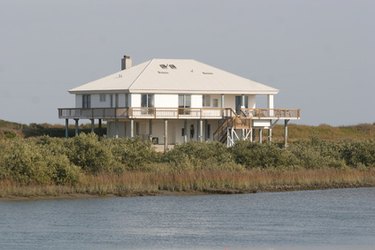Things You'll Need
Pile driving equipment
Building permit

Pile foundations have been around for years, even as far back as the Roman Empire. According to AmazingPlans.com, beach homes are often built on piling because of their close proximity to water and the rising and falling tides. A beach home should be elevated above the base flood level either on piling or a masonry foundation, reports "The Journal of Light Construction." Piling is used if the soil is unable to support the load of a traditional spread footing and foundation walls.
Preparation
Step 1
Obtain the proper building permit by contacting your local government to inquire about all existing building codes and requirements.
Video of the Day
Step 2
Clear the area and level the lot before driving piles. Fairly level terrain is needed in order for a pile-driver crane to maneuver.
Step 3
Stake out the area for your structure, driving stakes along the sides and at corners to indicate where piles should be driven.
Video of the Day
Procedures
Step 1
Contact a supplier to choose piling. Steel, concrete, wood, and fiberglass piling can all be used. The preference for one type over the other varies by region.
Step 2
Verify the best length of piles to use. Things to consider are the depth necessary to resist vertical uplift and horizontal loads, as well as flood elevation, ground elevation and the potential for erosion.
Step 3
Satisfy criteria for embedment depth, or how deep the piles must go. Engineers usually require at least 20 to 25 feet of embedment to get the bearing and security you need.
Step 4
Drive piles into the ground using a crane-mounted diesel- or air-powered hammer. Choose the double-acting hammer for precision and accuracy. Unlike the single-acting hammer, it does not have to be raised by cable after each blow.
Tip
Piles are often confused with piers but they are not the same. Piles are driven into the ground to support the foundation. Piers are used mainly to elevate the home above the ground and are usually supported at ground level by concrete footing.